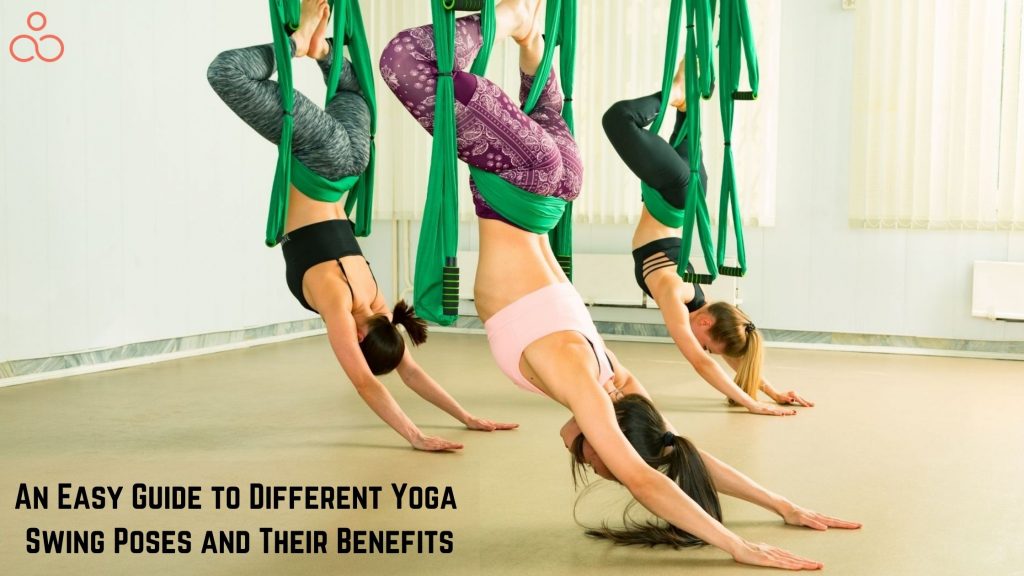Are you feeling less than enamored with your yoga mat? It is common to get bored with your conventional yoga routine, particularly if you have been practicing for some time now. Let us introduce you to a refined form of asanas to renew your relationship with yoga. Most of us are familiar with the benefits of incorporating yoga into your daily life. And we all love it.
Let us revisit the feeling of how our bodies respond to yoga poses together. Yoga creates magic for our minds and bodies. It is a marriage of inner peace and strength. But did you know if you keep the same routine, over time your body can become less responsive to it? In other words, you can start to sense a detachment.
Just like a romantic relationship, it is important for you to keep experimenting with different exercises to keep yourself motivated. As a yogi, one thing you can try out is a yoga swing pose.
What Is a Yoga Swing and its Purpose?
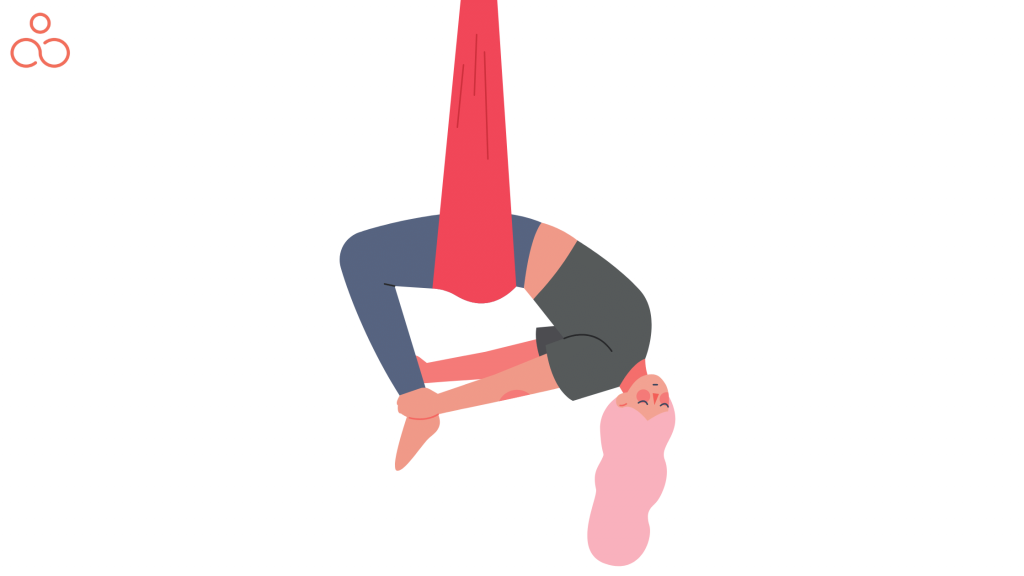
You can sense the fun in the name. What’s not to like about a swing? The yoga swing is an unconventional take on yoga, also known as aerial yoga. Even for regular practitioners, doing an asana on the mat is completely different to doing the same asana in the air. It is a lot like regular yoga, except you will be lifting your body up in mid-air to form yoga swing poses. It may look like a difficult form of yoga, but trust us, it can also be beginner-friendly.
A yoga swing or a hammock is designed to perform a modern form of yoga, which is a combination of traditional yoga poses mixed with aerial acrobatics. All the poses are done with the help of the swing. Some may face mobility limitations or difficulties with flexibility on a yoga mat. An aerial yoga swing will help you to tackle such issues. It is believed that many people have found that their yoga poses are much more stretched out on the swing.
A yoga or anti-gravity swing has helped many to overcome difficult poses. We recommend you to join a class to be supervised by a certified instructor, specializing in aerial yoga. Your instructor should be able to guide you with the basic asanas at first, followed by the trickier and fancier asanas on the swing.
Yoga swing poses can be really rewarding, and there is something in it for everyone. A first-timer can use the swing as an additional support to stretch out their muscles and form simple poses. A yoga swing for beginners is a wonderful way to discover the capabilities of your body. An expert can try an advanced level pose that requires enhanced core strength and flexibility. It has also been recognised as a treatment or therapy for back pain. All in all, it is unlikely for you to be unaffected after trying it.
How to Practice in a Yoga Swing
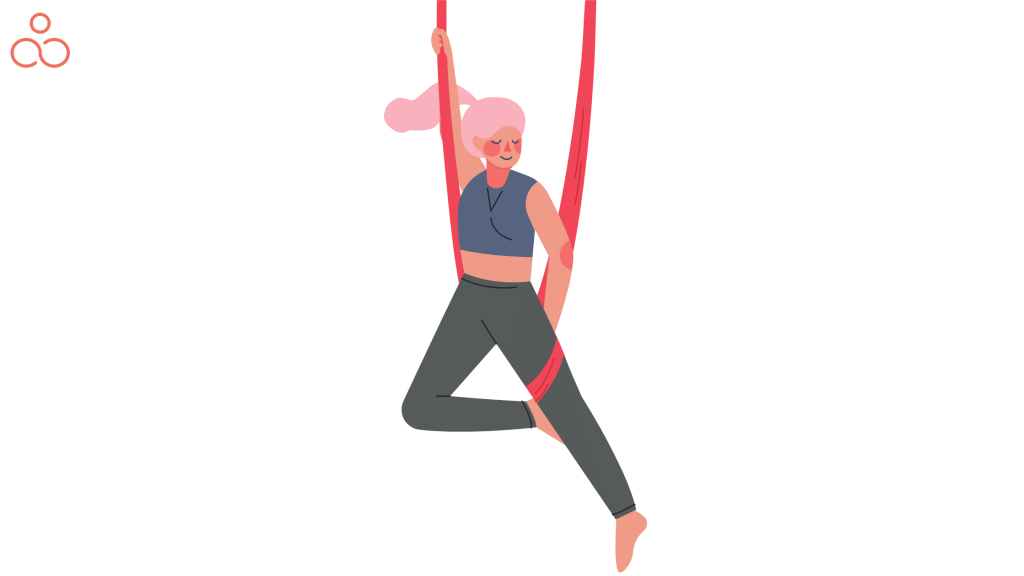
As the name suggests, hanging yoga poses are performed on a swing or hammock. There are many ways to incorporate it, and it is often categorized separately in terms of yoga styles. You must be mindful about the steps you need to follow to use a yoga swing.
Step 1
Warm up and do it religiously every single time. This is essential before starting out your yoga swing poses. You have to prepare your body before you use a yoga swing. Activate the muscles of your body and stretch out your arms and legs.
Step 2
If you have activated all your muscles for the intense session, stand on the ground with your back facing the yoga swing. If your swing has a handle, then reach for the handles to have a balanced grip. Now reach for the edges and open the “seat” part. Use your knuckles to wrap the edges of the swing and give yourself a small push to sit on the swing. It will feel like a subtle pull-up. Once you have placed yourself on the swing, take a moment to breathe in and out in this position.
Step 3
You are now ready to shift your hands to the middle of the swing. Focus on your grip and gradually lean back, forming a straight alignment between your shoulders and hips. Open up your knees, stretch out your legs, and use your shin to wrap the swing, slowly shifting to your ankles.
Quick Tips
We advise you to avoid practising with a full stomach. For any yoga practice, or in fact any physical exercise, it’s ideal to wait for three hours after you have eaten your last meal. You have to allow your body to digest the meal fully, before jumping onto a swing. Any rigorous movement can make you uncomfortable, particularly for the upside down poses on the swing.
Test the swing before your practice. It’s is important to feel secure when performal aerial yoga. So check for the swing’s weight limit. Ask your instructor if you have joined a class. Feel free to look around for the ropes and chains condition. Make sure they look strong and sturdy, if you are unsure, please don’t hesitate to discuss it with your teacher. The fabric of the swing that will hold your body also needs to be in solid condition, so please ensure your safety before you start.
Dress for the occasion. Remind yourself to wear appropriate attires, as yoga on the mat is totally different to yoga on a swing. Your skin is more exposed to fabric burns and prone to accidents if you are not dressed carefully. Don’t wear loose fitted clothes, as it can get in the way of your grip and flow. We always advise to wear fitted sports wear, preferably full pants and full sleeves. Try to pick clothes that are plain and simple without zippers and embellishments to avoid mishaps on the swing.
Lastly, get an appointment with your general medical doctor, or a physiotherapist before you have a go on the yoga swing. If you are aware of any condition like sciatica, back problems, spondylolisthesis, vertigo or disc issues, please consult a doctor. Special warning for women who are pregnant, as the movements on the swing might not be suitable for you. It’s best to get a green light from your doctor before you pursue aerial yoga.
Different Yoga Swing Poses to Try
The most common one is aerial yoga, which is a hybrid mix of pilates, gymnastics, acrobatics, and traditional yoga poses. It is a very effective and full-blown workout.
Yoga poses on a swing have evolved over the years. In the beginning, there were only a few poses for backbends and inversions considered to be yoga swing poses. Now, however, most yoga poses can now be performed on the swing, thanks to the continuous effort by yoga gurus.
Today, there are innumerable ways of using the yoga swing to get the most out of your practice. The most common ones are inversion, backbends, and body strengthening poses.
Warrior Pose
This is an excellent way to demonstrate your balance and flexibility. You will feel the main tension around your hips, which is a great opportunity for you to engage your core and stabilize your hips. This particular pose helps you to become more aware of your body strength. Warrior pose improves your overall body muscle movements and balance.
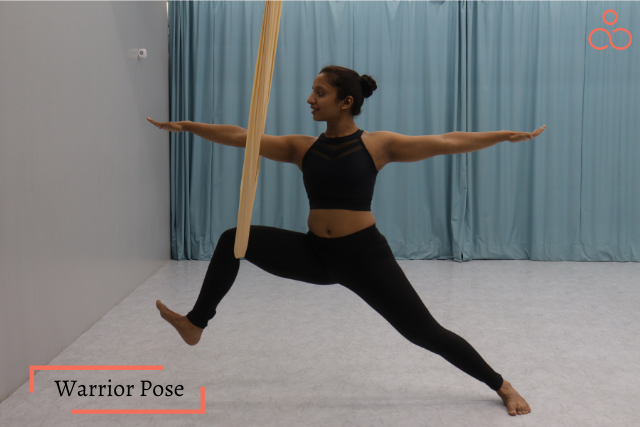
Mountain Pose
A mountain pose is usually the introductory pose in most classes. Raising your arms and engaging your core enhances your balance on the swing. It also works like a warm-up as it stretches your torso, abdomen, legs, and arms, stabilizing your balance. Many people finish their routine with a mountain pose as well.
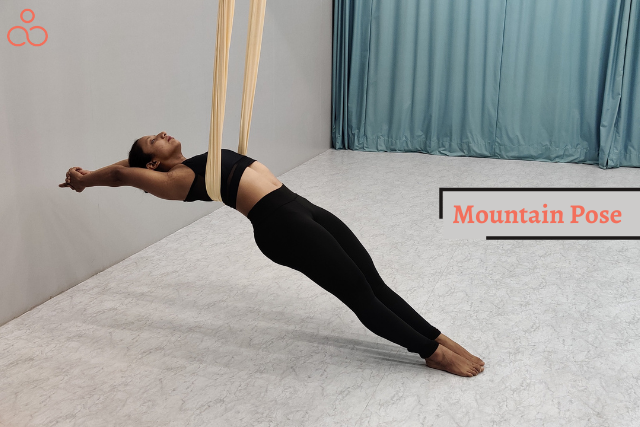
Inverted Bow Pose
This is a very common therapy for back injuries. It helps immensely with spine decompression. Again, warm-up is essential to attempt any backbend pose on a swing, or even on a mat.
Now you can start to stretch your arms to grab the top section of the swing. Then extend the arms up so you can grab the top part of the swing. Shift back steadily. Focus on lowering your back slowly as you slide your grip down. You can choose to free your arms or do a bow down pose.
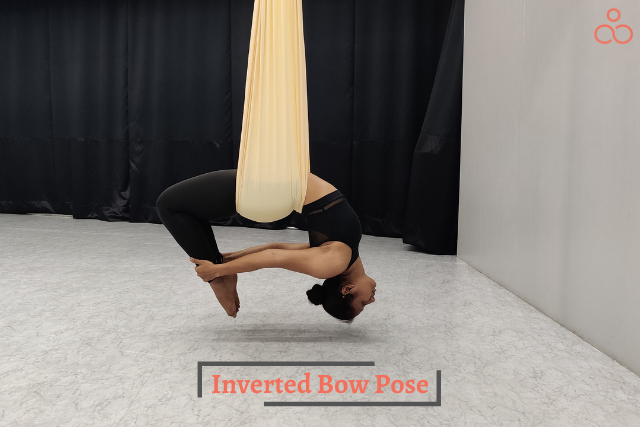
Superman Pose
This for the advanced yogis. You get into position by lying down on your belly. You must have ample core strength to perform this pose. You will be slowly lifting your upper and lower body upwards, using the middle part as a foundation. Focus on stretching out your hands and legs to get the maximum benefit from this pose.
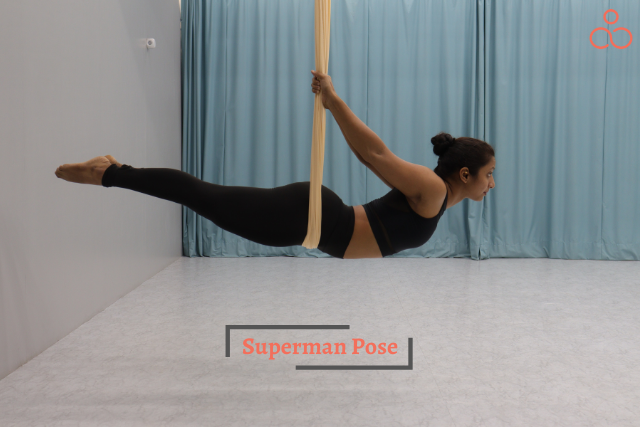
Reclining Angle Pose
This is a pose against gravity. You will be facing upside down. The trick is to use your hands to slide down your hips gradually. It’s important to find your stability before you free your hands. Release your hands and touch the floor once you are confident. Your legs will feel heavy, and that’s okay; let it sink it. Breathe in and out five times in this position.
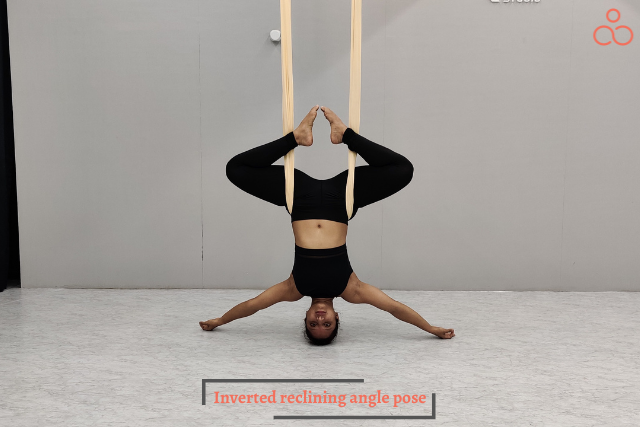
Air Crunches
Air crunches need a lot of core strength. As you may know, crunches are the best for abs. Air crunches are even better. You are expected to have to body forward facing, before you release on the swing. Place your hands behind your head. Breathe regularly as you would for crunches on the mat. The trick is to place your back on the swing comfortably. Remember your back will not be on a flat surface, so balance it well before starting your crunches.
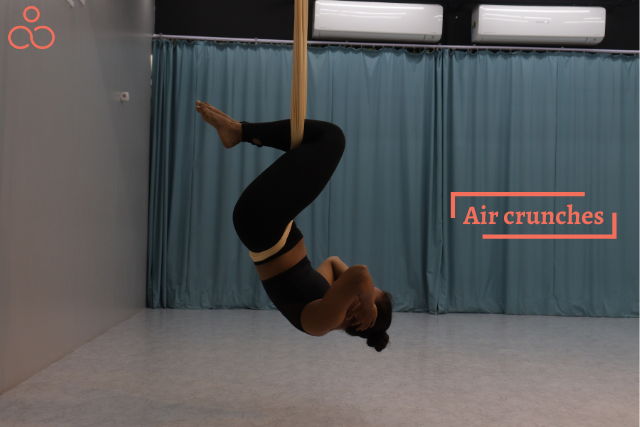
Aerial Lunges
Lunges on a swing can seem life-changing. You will feel your hamstrings and hips opening up like never before. Allow the swing to support the weight of one while the other hangs. Balance your body weight and gently lean forward, maintaining your alignment. Once you have fallen into the rhythm of it, take five breaths. Now do the same for the other side.
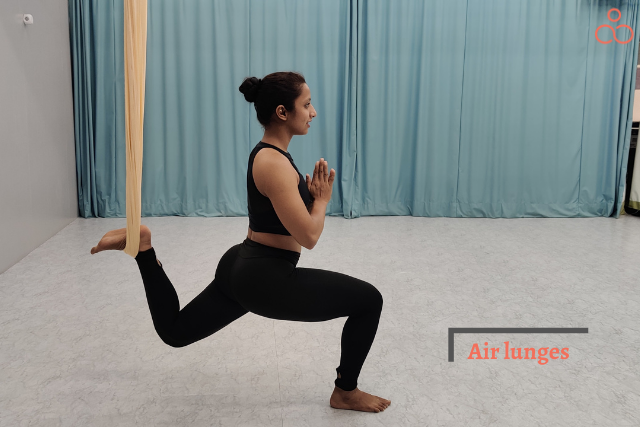
Supported Chair Pose
Like most poses, the supported chair pose also needs balancing, strengthening, and stretching. Like the name, you are expected to perform this pose in a sitting position on the swing. It will help to strengthen your quads and open up your chest. If you focus on the right alignment, you will find a visible improvement in your balance.
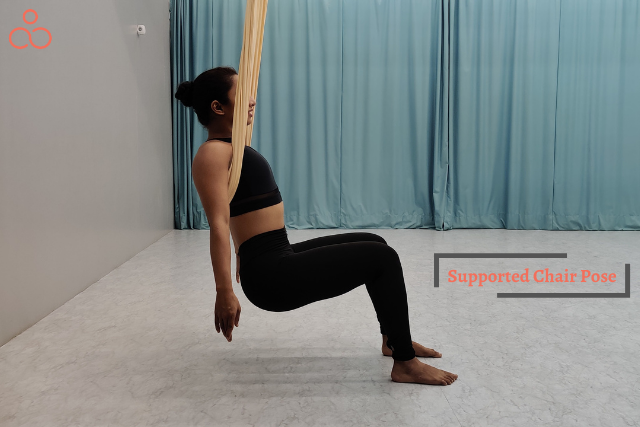
Star Inversion
Inversions can be terrifying. The thought of stretching out your body over your head does not look pleasant. But a yoga swing makes it worthwhile. In fact, yoga swings facilitate challenging poses, making your experience a pleasant one. Extend your arms and legs and stretch out to your maximum capacity slowly, and amazing results will follow.
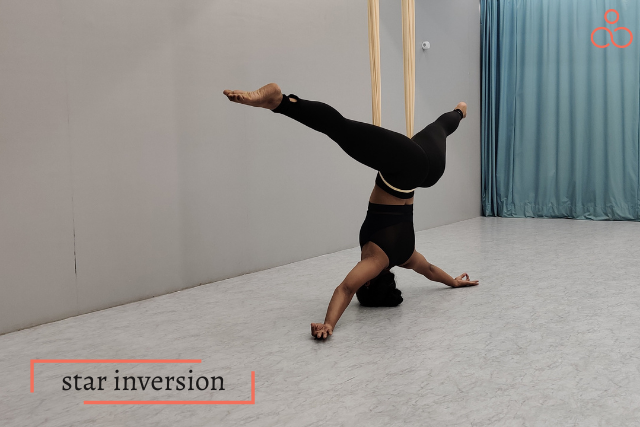
Conclusion
Remember to trust your process, particularly if you are a beginner. You will be releasing your body weight on the yoga swing or hammock, and having faith in yourself and your swing is crucial. If you are practicing in a studio, you will receive assistance with your alignment and poses. They usually use UpCircleSeven Yoga Swings, the most reliable one in the market. But if you are thinking of practicing at home, you will need to get a reliable swing to support your practice. We recommend you to think about safety and reliability to make your experience worthwhile.

